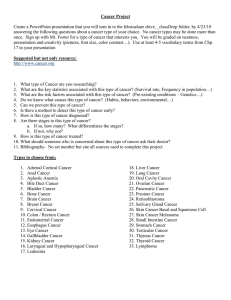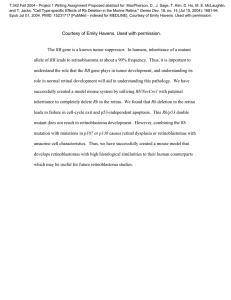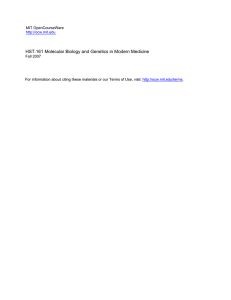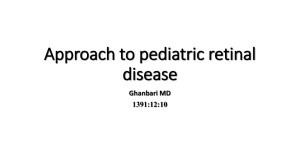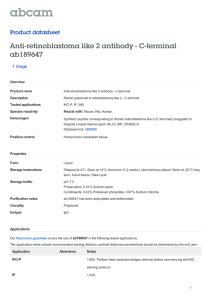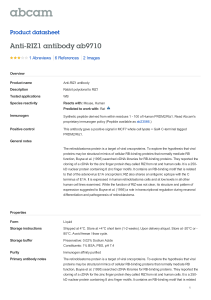Problem set # 2 Problem # 1
advertisement
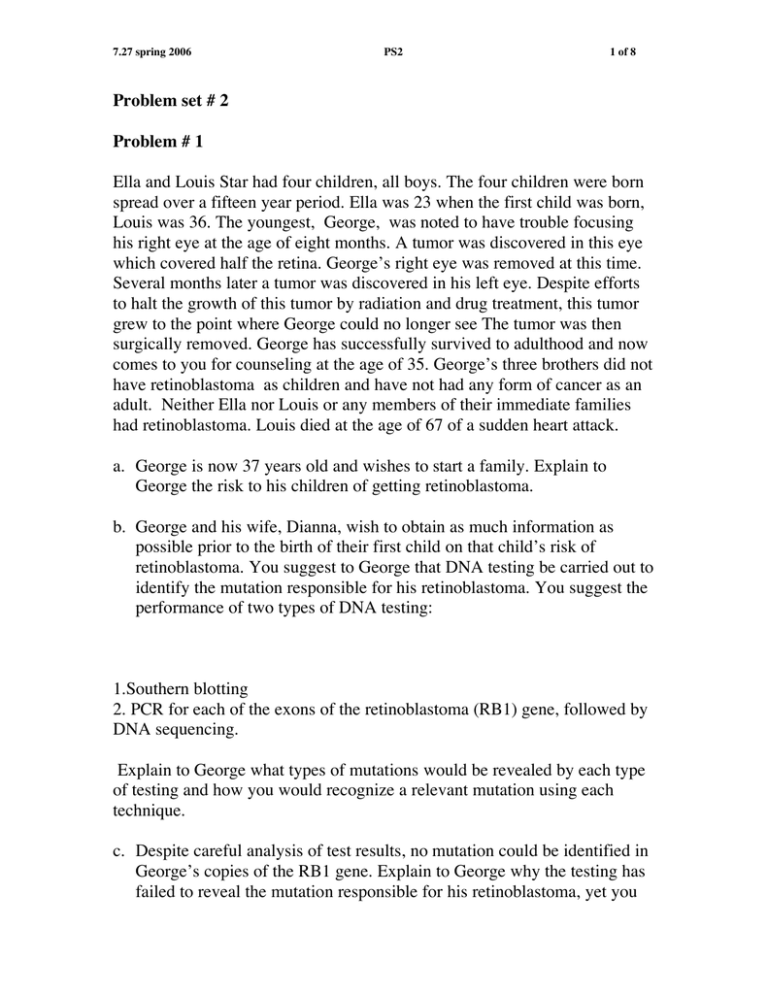
7.27 spring 2006 PS2 1 of 8 Problem set # 2 Problem # 1 Ella and Louis Star had four children, all boys. The four children were born spread over a fifteen year period. Ella was 23 when the first child was born, Louis was 36. The youngest, George, was noted to have trouble focusing his right eye at the age of eight months. A tumor was discovered in this eye which covered half the retina. George’s right eye was removed at this time. Several months later a tumor was discovered in his left eye. Despite efforts to halt the growth of this tumor by radiation and drug treatment, this tumor grew to the point where George could no longer see The tumor was then surgically removed. George has successfully survived to adulthood and now comes to you for counseling at the age of 35. George’s three brothers did not have retinoblastoma as children and have not had any form of cancer as an adult. Neither Ella nor Louis or any members of their immediate families had retinoblastoma. Louis died at the age of 67 of a sudden heart attack. a. George is now 37 years old and wishes to start a family. Explain to George the risk to his children of getting retinoblastoma. b. George and his wife, Dianna, wish to obtain as much information as possible prior to the birth of their first child on that child’s risk of retinoblastoma. You suggest to George that DNA testing be carried out to identify the mutation responsible for his retinoblastoma. You suggest the performance of two types of DNA testing: 1.Southern blotting 2. PCR for each of the exons of the retinoblastoma (RB1) gene, followed by DNA sequencing. Explain to George what types of mutations would be revealed by each type of testing and how you would recognize a relevant mutation using each technique. c. Despite careful analysis of test results, no mutation could be identified in George’s copies of the RB1 gene. Explain to George why the testing has failed to reveal the mutation responsible for his retinoblastoma, yet you 7.27 spring 2006 PS2 2 of 8 remain confident that a mutation is present in one of his copies of his RB1 gene. Propose at least one type of mutation which could have escaped detection in the screen for mutation you have carried out and yet be responsible for George’s retinoblastomas. d. George asks if there is any significance to the fact that he is the youngest of the four brothers in relation to his case of bilateral retinoblastoma. What answer would you give to this question. e. George has read that in cases like his where the mutation in the RB1 gene which is responsible for his retinoblastoma can not be identified, it is possible to determine through testing based on genetic linkage whether he has transmitted the copy of the RB1 gene from his father, Louis, or his mother Ella, to his child. He has also read that determining this information would have be relevant to his child's risk of receiving a defective copy of the RB1 gene. Give an explanation to George as to why knowing whether he has transmitted Louis's or Ella's copy of the RB1 gene will affect the risk of retinoblastoma to his child. f. DNA samples are obtained from George, George’s mother, Ella, his wife, Dianna and his brothers John, Paul and Richard. A DNA sample from Louis is unavailable. Four single nucleotide polymorphisms within the retinoblastoma gene aretested. The following results are obtained. Individual testedSnp 842 George 2,2 Ella 2,2 Dianna 1,1 Richard 2,2 John 2,2 Paul 2,2 Snp657 1,1 1,1 1,2 1,2 1,2 1,2 Snp351 2,2 1,2 2,2 1,2 1,2 1,2 Snp899 1,1 1,1 1,2 1,1 1,1 1,1 Draw a pedigree using standard symbols to display these results. Indicate the haplotype for these markers for each family member. Based on this data determine Louis's genotype for these markers and show his haplotype on your pedigree. Do these results give any new information which can be used to assess the risk for retinoblastoma of a newborn child to George and Dianna? Explain. g. Dianna becomes pregnant. During the last trimester of Dianna’s pregnancy, a new VNTR DNA marker from the retinoblastoma gene 7.27 spring 2006 PS2 3 of 8 becomes available and it is tested on the DNA samples from George’s family. The following results are obtained. Individual Snp 842 Snp657 Snp351 Snp899 VNTR 505 George 2,2 1,1 2,2 1,1 5,8 Ella 2,2 1,2 1,2 1,1 5,7 Dianna 1,1 1,2 2,2 1,2 4,5 Richard 2,2 1,2 1,2 1,1 5,7 John 2,2 1,2 1,2 1,1 5,7 Paul 2,2 1,2 1,2 1,1 5,7 Give an explanation to George of how these new data make it possible to give an assessment of the risk of the fetus for retinoblastoma which is different from the risk assessment possible before the VNTR 505 data was obtained. h. Two months later George and Dianna’s daughter Alanis is born. The genoptypic data obtained from Alanis’s DNA is as follows: Snp 842 Snp657 Snp351 Snp899 VNTR 505 Alanis 1,2 1,1 2,2 1,2 5,5 These data indicate that Alanis’s risk for retinoblastoma is lower than the estimate that could be made of her risk for retinoblastoma prior to this round of testing. Explain to George and Dianna why this is the case? 7.27 spring 2006 PS2 4 of 8 i. Alanis is examined for retinoblastoma tumors every three months for the next five years, but no tumors are found. Dianna and George decide to have another child. They in fact have twins, Jewel and Sid. When Jewel’s eyes are examined at birth she has no retinoblastoma tumors, but Sid is found to have tumors in both his eyes. The genotypes of the twins are shown below. Explain to George and Dianna the risk for retinoblastoma to Jewel based on these data. Jewel Sid Snp 842 Snp657 Snp351 Snp899 VNTR 505 1,2 1,2 2,2 1,1 4,5 1,2 1,2 2,2 1,1 4,8 j. Sid’s tumors are removed and DNA is isolated for later genotyping. What genotype for these markers would you expect in a tumor from Sid if the second hit in the tumor analyzed was a point mutation in exon 4 of the RB1 gene causing a CAG codon to be changed to a UAG codon? k. What genotype for these markers would you expect to observe in a tumor from Sid in which non-disjunction of chromosome 13 was the event responsible for the second hit in his tumor? 7.27 spring 2006 PS2 5 of 8 Problem #2 . Hereditary spherocytosis is a red cell disorder which is inherited in an autosomal dominant pattern with 100% penetrance. The gene responsible for HS is on chromosome 1. In order to do a bone marrow transplant, it is necessary that the donor match the recipient at the HLA locus on chromosome 6. However, it is also essential that the donor of the bone marrow not carry a disease allele. Grady and Josephine (Jo) are the parents of a child, Karim, with HS. Jo herself suffers from HS. Grady and Jo are genotyped and shown to each have two different haplotypes at the HLA locus. Grady and Jo have a newborn son, Manny. a.What is the likelihood that Manny will be a match at the HLA locus and not carry the HS gene. b. What would these odds be if Grady is homozygous for his alleles at the HLA locus. c.What would these odds be if Grady and Jo have exactly the same alleles on one copy of the HLA locus but have different alleles from each other on their other copy of the HLA locus. Problem # 3. In a screening program to detect carriers of β-thalassemia in Sardinia the incidence of children with β-thalassemia was found to be approximately 1 child per 400 children born. a) What is the proportion of the population who are heterozygous for a β-thalassemia allele? b) What is the proportion of matings in this population that could produce an affected child? c) A woman from Sardinia is found through a screening program to be a heterozygous carrier of a β-thalassemia allele. She then moves to Tuscany where the incidence of children with β-thalassemia is 1 in 1600 children born. What is the likelihood that she will have a child with β-thalassemia if she marries a man from Tuscany. 7.27 spring 2006 PS2 6 of 8 Problem #4 α-1 antitrypsin is a circulating protein made in the liver which plays a key role in maintaining alveolar function in the lung. An individual who is homozygous for the z allele of α-1 antitrypsin has an activity for α-1 antitrypsin of 10 units or less. zw heterozygotes have activity levels for α-1 antitrypsin which vary between 30 and 60 units and individuals who are homozygous ww have activity levels for α-1 antitrypsin which vary between 80 and 120 units. Population studies are carried out on a series of populations to measure α-1 antitrypsin levels. The following results are obtained. School children between 10 and 15 years of age Units #of individuals 0-10 30-60 80-120 102 596 902 Adult non smokers aged 40-55 Units #of individuals 0-10 30-60 80-120 99 603 907 Adult smokers aged 40-55 Units #of individuals 0-10 30-60 80-120 65 613 922 7.27 spring 2006 PS2 7 of 8 Adult non smokers ages 65-75 Units #of individuals 0-10 30-60 80-120 62 614 924 Adult smokers ages 65-75 Units #of individuals 0-10 30-60 80-120 11 632 965 Which populations are in Hardy-Weinberg equilibrium? How do you explain the deviations from Hardy-Weinberg equilibrium which are observed?
